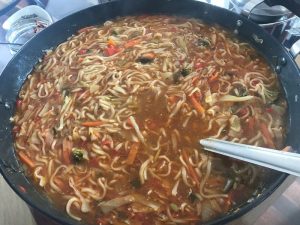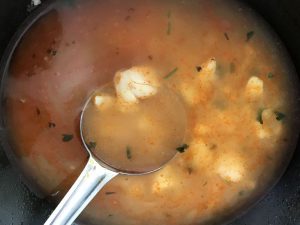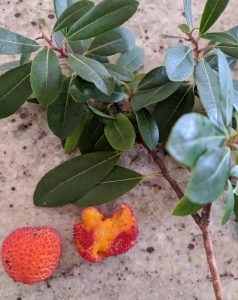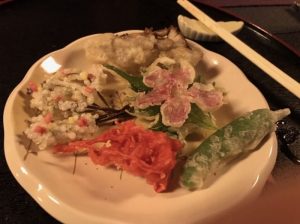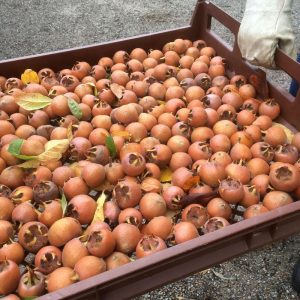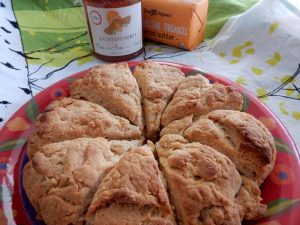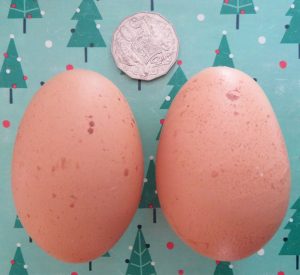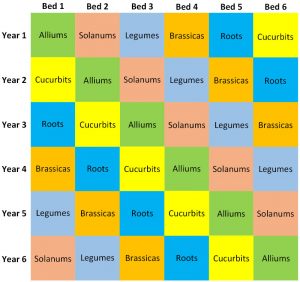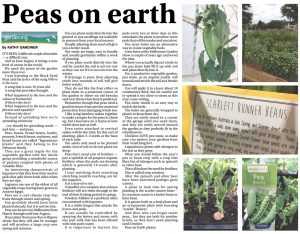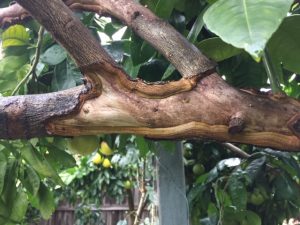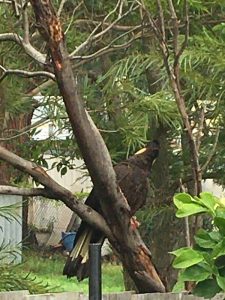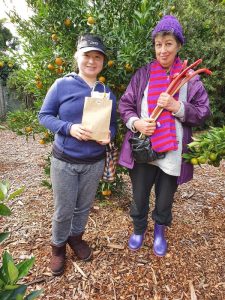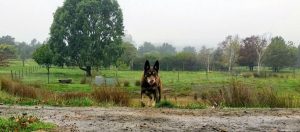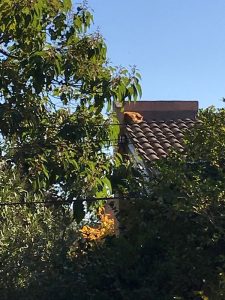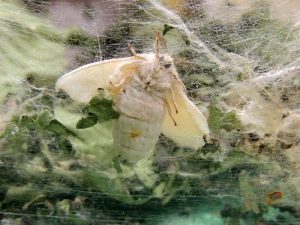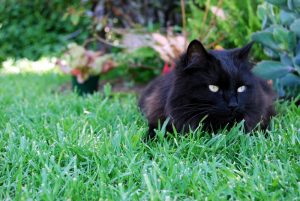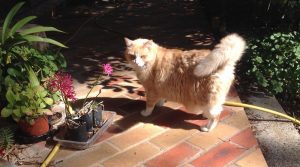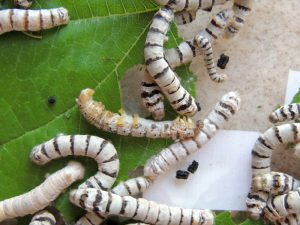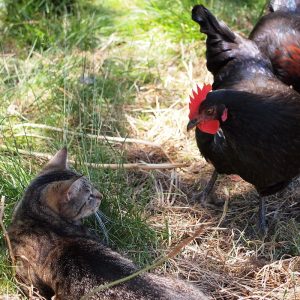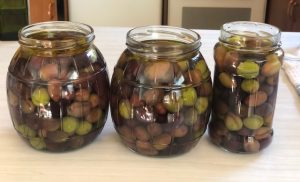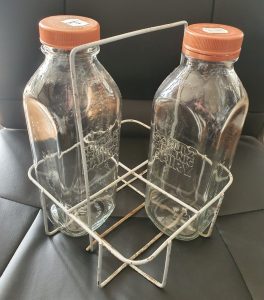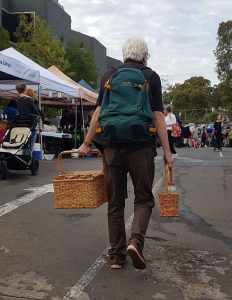Thanks to all the people who have contributed to this week’s newsletter: Ann Stanley, Cath Lyons, Darryl Wilson, Jo Douglas, Karin Motyer, Lucinda Flynn, Maude Farrugia, Megan Goodman, Pam Jenkins, Richard Rowe, Robin Gale-Baker, Sabi Buehler, Sean Flynn, Shelley Evans and Tracey Bjorksten.
Some of you received last week’s newsletter on Thursday rather than on Wednesday, whilst others of you may never have received the newsletter at all. Here’s why. As usual, I sent the newsletter out at 6.15am on the Wednesday. However, for reasons too complicated to discuss here, the newsletters go via Lithuania and there was a problem with the Internet in Lithuania last Wednesday. It took them around 24 hours to sort out the problem, hence the delays.
This seems an opportune time to suggest that you add my email address, (guy@localfoodconnect.org.au) to your Google or email address book. A chronic problem with all newsletters is trying to avoid them getting classified as either ‘spam’ or ‘promotions’ and not reaching your inbox as a result. If you add my email address, (guy@localfoodconnect.org.au) to your Google or email address book, this should stop this happening to you as it effectively says to your email provider that you are happy to receive emails from me (the technical word is ‘whitelisting’). (The whole Lithuania thing is actually an attempt to lessen these sorts of problems and it has worked well until last week.)
Which farmer’s markets will be happening this weekend?
On Saturday: Coburg. Not Abbotsford Convent or Wonga Park.
On Sunday: Alphington and Eltham.
Food swap news
The Heidelberg Food Swap, organised by Transition Warringal and located at St Johns Riverside Community Garden, has re-started.
Stuart and Kelli Lewien’s garden in Heathmont
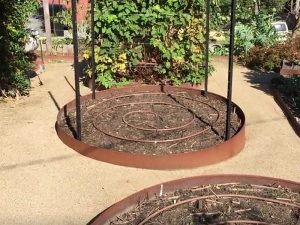 We have continued to find ways of generating new garden write ups during COVID-19 without having to visit the properties. This time, it is Stuart and Kelli Lewien’s garden in Heathmont and the writeup is in their own words. It also includes 6 videos, each focusing on a particular aspect of the garden.
We have continued to find ways of generating new garden write ups during COVID-19 without having to visit the properties. This time, it is Stuart and Kelli Lewien’s garden in Heathmont and the writeup is in their own words. It also includes 6 videos, each focusing on a particular aspect of the garden.
The garden was designed by John Ferris from Edible Forest Gardens and is permaculture-inspired.
Read about Stuart and Kelli Lewien’s garden.
Apted’s Orchards
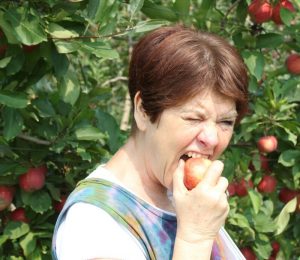 Ann Stanley has written a short article about Apted’s Orchards (pdf). Apted’s Orchards grow apples and pears in Arthurs Creek and Kinglake West. You can buy their produce at Eltham Farmers’ Market, their farm gate in Arthurs Creek, Bolton Street Fruit Market in Eltham, Local Fine Foods in Diamond Creek or Rivers Cafe & Farm Shop in Yarrambat.
Ann Stanley has written a short article about Apted’s Orchards (pdf). Apted’s Orchards grow apples and pears in Arthurs Creek and Kinglake West. You can buy their produce at Eltham Farmers’ Market, their farm gate in Arthurs Creek, Bolton Street Fruit Market in Eltham, Local Fine Foods in Diamond Creek or Rivers Cafe & Farm Shop in Yarrambat.
Robin discusses the appealing medlar!
In my [Robin’s] garden, a fruit tree needs to serve several purposes and our combined total of 40 fruit trees need together to meet a range of criteria. These include giving us fruit year round, beautiful flowers and autumn colour. The medlar is one of our favourite trees because it gives us winter fruit, late summer cream flowers tinged with pink, and autumnal leaves that range from gold to orange to deep red and last through to the end of June.
The medlar is a lesser known fruit tree and not often grown (although there are some spectacular trees in old gardens). It bears fruit that most people do not recognise. They are about the size and shape of a rounded crab apple with a calyxed bottom. Unripened, the fruit is green and moves through orangey colours to a deep russet to brown. In contrast to what many books say, I don’t find this unappealing. The fruit tastes like a tangy apple sauce and has the texture of thickened sauce that is deep brown in colour. To the uninitiated eye it may look like the ripe flesh has rotted but it is this over-ripeness that gives medlar its distinct taste. The process is called ‘bletting’. Bletting means that the fruit has fermented beyond ripeness and this is a very different process to rotting. Other fruits that blet include persimmon and quince.
Bletting can be achieved in two ways. Either remove the fruit and store on straw or paper towel or newspaper in a single layer, calyx down and stem upward, in a warm and airy place (darkness not necessary) for 2-3 weeks until soft or leave on the tree and pick them when soft. Sometimes the fruit will drop before being fully ripe and then should be stored as in the first method. You can also dip the stalks in a strong salt and water mix to prevent any mould setting in.
The best way to prepare a medlar for eating is to strip it out of the skin by squeezing it from the calyx end and keep stripping it until all the pulp is out, especially that close to the skin. I strip it into a strainer as it has quite large, hard stones and use the back of a dessert spoon to press it through. I serve it with cheeses just as you would use quince paste. It can also be added to cream, apparently goes with any wine, and is best known in either medlar jelly [see Jo’s recipe below] or medlar cheese (which is like a curd). Sally Wise’s book entitled A year in a bottle contains recipes for both medlar jelly and medlar liqueur.
The medlar tree itself has its origins in the Balkans, Iran and Turkmenistan despite its botanical name being Mespilus germanica. There is a large type called Dutch with fruit 5-6cm in diameter and a smaller type, the Common Medlar, of which the Nottingham variety is best known, with fruit 2-2.5cm. I grow the Common Medlar and, at present (mid June), mine still has around 150 fruit on it. Plant medlars in winter and train them early to a vase shape like an apple tree.
Medlars are unfussy about soil type, other than disliking chalk soils, but require good drainage. They do not need fertilising and they need very little pruning other than to keep the centre open for good ventilation and dead branches removed. They are rarely attacked by pests or disease. They like a sunny position but will grow in partial shade and it is best to provide some shelter from wind as the branches are brittle and flowers can blow off in strong wind.
Read more of Robin Gale-Baker’s fruit tree growing tips.
A recipe for medlar jelly
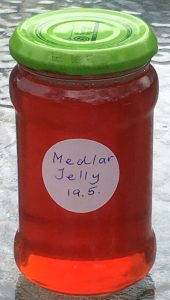 Last week, Jo Douglas sent in a photo of the medlars that had been harvested from a tree in Montsalvat. She has now sent in David Lebovitz’s recipe for medlar jelly.
Last week, Jo Douglas sent in a photo of the medlars that had been harvested from a tree in Montsalvat. She has now sent in David Lebovitz’s recipe for medlar jelly.
Ingredients
1.4 Kg ‘bletted’ medlars
1 green apple
½ lemon
600g sugar
‘Bletted’ means that the medlars are soft and brown inside.
Method
Rinse and quarter the medlars, and put them in a large pot – skins, seeds and all.
Chop up the apple and add, including the seeds and core.
Add the lemon and pour in enough water so that the medlars are floating in water (around 2 litres).
Cook the mixture until it begins to boil, then reduce the heat and let it cook at a low boil for 45 minutes.
Line a colander with several layers of muslin, set it over a deep bowl and ladle the cooked medlars and their liquid into the colander. Let it strain overnight undisturbed. Do not press down on the cooked fruit to extract more juice from it or your jelly will be cloudy.
The next day, pour the liquid into a large pot – you should have about 1 litre. Put a small plate in the freezer. Add the sugar to the juice in the pot and cook the jelly until it reaches 104degC or until it gels.
To test the jelly, put a spoonful on the cold plate from the freezer and let it chill a few minutes. If, once cold, it wrinkles when you push it with your finger, then it’s done. If not, continue to cook the jelly until it gels.
When ready, if you wish, you can offset the sweetness with a few drops of fresh lemon juice.
Ladle the jelly into sterilised jars.
Read other Jo Douglas recipes on our website.
More on the Irish strawberry tree (Arbutus unedo)
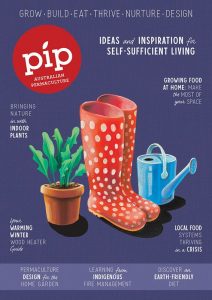 Last week, Maude Farrugia wrote in to say that she had written a guide to the Irish strawberry tree in the latest issue of Pip Magazine. I asked Maude if we could re-print any of the guide. She consulted her editor (Robyn Rosenfeldt) and has sent in this:
Last week, Maude Farrugia wrote in to say that she had written a guide to the Irish strawberry tree in the latest issue of Pip Magazine. I asked Maude if we could re-print any of the guide. She consulted her editor (Robyn Rosenfeldt) and has sent in this:
“The Irish strawberry tree is so named for its prevalence in Ireland (though it is native to much of Europe) and its fruit’s resemblance to (you guessed it) strawberries. A member of the heath family, along with blueberries, the tree has been culturally and historically important in the many European areas it is native to. The scientific name [Arbutus unedo] references Pliny the Elder, and is commonly thought to refer to the fact that the fruit is not as delicious as a strawberry (‘unedo’ is a contraction of Pliny’s ‘unam tantum edo’ meaning ‘I only eat one’). But don’t let that put you off, they’re still quite palatable, and a very fuss-free fruit to grow.
“These medium sized evergreen trees are long-lived, grow well in a wide variety of soils and will tolerate the extremes of drought and frost (though variable weather can impact on their fruiting). Sweet nodding bell-shaped flowers are a boon for bees, and have made Arbutus unedo a popular ornamental tree. So if you don’t have room for one yourself, they can be commonly foraged in urban settings. Traditionally they have been wild foraged too, which makes them very easy to grow as they require little cultivation, no pruning or irrigation and will be quite happy if simply left to their own devices.
“For a full growing guide, subscribe to Pip Magazine“
Shelley Evans also wrote in: “Last week I made feijoa and Irish strawberry sorbet. I then used this as flavouring for my homemade ice cream. My very fussy family loved it and want more but they will have to wait until next year’s harvest.”
Thanks, Maude and Shelley!
More on gall wasp
Following last week’s discussion about Leaf, Root & Fruit’s experiment of different gall wasp treatments, Gardening Australia has weighed in on the subject. Watch their video.
Do you know?
Darryl Wilson writes in: “My wife is looking into medicinal plants for pain relief, healing of injuries and reduce inflammation.
Are there any courses that she may be able to pursue? The back story is that her brother is paraplegic living in a third world country with limited medicines. His welfare is of concern to us and this is our next step into looking for other aides for his condition.” Has anyone got any suggestions of courses in medicinal plants?
No, you didn’t know
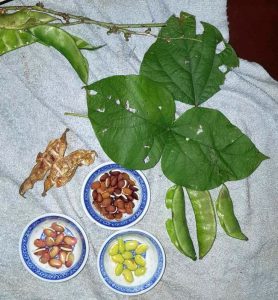 Although quite a lot of you clicked on the picture of Stella Ramos’ legume, no one wrote in to say what it was. Anyone want to try this week? As Stella said, “The pods are a bit fluffy. All the beans have a distinct white line along the edge.” Email me.
Although quite a lot of you clicked on the picture of Stella Ramos’ legume, no one wrote in to say what it was. Anyone want to try this week? As Stella said, “The pods are a bit fluffy. All the beans have a distinct white line along the edge.” Email me.
What veggie seeds to plant in July
Here is a list (see the July planting guide for more detail):
Beetroot
Coriander
Lettuce
Mustard greens
Onion
Peas
Radish
The shortest list of the year.
A survey about food growing and COVID-19
Sustain and others invite you to complete a 10 minute survey about food growing during and after the current crisis. The stated aims of the survey are:
- To investigate the extent of edible food growing by Australians in 2020.
- To find out as best we can the impact of the COVID19 restrictions and ongoing legacy on the take-up and / or expansion of edible food growing by Australians.
- To understand the experiences of Australians with edible food growing during and after the COVID19 restrictions.
- To identify what resources and supports Australians may want or need to continue and / or expand their edible food growing.
‘Crowd harvest’ – Winter citrus
Lemon trees and other citrus are often heavily laden in the middle of winter. Gardeners with excess are invited to give them during the first half of July to one of the not-for profit organisations listed in the next paragraph who will, in turn, provide them to those facing food insecurity. Read this Facebook post for more information.
DIVRS in Preston, Elisha Care in Croydon, Now and Not Yet Cafe in Warrandyte or STREAT in Collingwood.
Foodscaping

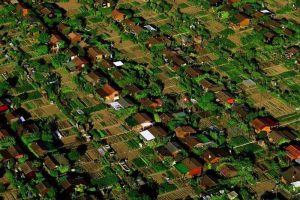
Sabi Buehler has sent in this photo (left hand picture), which was captioned Foodscaping in Geneva, Switzerland.
It is actually becoming increasingly difficult to distinguish what things on the Internet are true and what are fake. Sabi’s photo looked too good to be true so I decided to investigate. My conclusion is that the photo is real and dates back to around 2013 but that the ‘houses’ are actually garden sheds and that the whole area is effectively one big community garden. More specifically, the place is called Jardins familiaux de Bel Essert and its coordinates are 46°13’00.7″N 6°06’36.2″E (references/sources available on request). The right hand photo is of the same place using Google maps – see how small the ‘houses’ are compared to the houses outside of the area.
Wikipedia has a page on foodscaping
Berry circles of life
A ‘circle of life’ photo of a blackberry is currently doing the rounds on Facebook. It is reproduced below together with less commonly circulated equivalents for blueberries and strawberries.
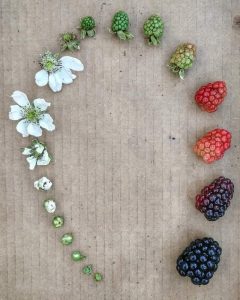 |
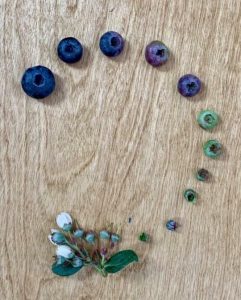 |
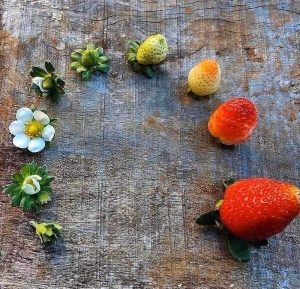 |
| Blackberry | Blueberry | Strawberry |
Want to do some paid hand weeding?
Susan is fighting a losing battle with oxalis and needs some help! $20 per hour. Eltham. If interested, email me and I’ll pass your email onto Susan.
Changes in Eltham eateries
The Missing Gorilla has closed down.
Earthbound Bolton has changed hands.
A new pizza place called Al’s Pizza has open where Bolton Pizza and Pasta used to be.
Guy’s veggie growing tip – moon phase planting
Lots of people (including, by anecdote, many farmers) practice something called moon-phase planting. There are three very different reasons why you might want to consider moon-phase planting, whereby different types of veggie are planted at different times in the moon’s 29½-day lunar cycle. The first possible reason is that you believe in it. The second possible reason is because it helps to impose discipline on your veggie growing activities. The third possible reason is to help give your life cadence.
To believe in it, you have to understand it a bit. The basic idea/assumption/rationale/sophistry is that one wants root crops to grow downwards, and thus when the upward pull of the moon is lessening, and thus when the moon is waning. By contrast, one wants leafy and fruity crops to grow upwards, and thus when the upward pull of the moon is increasing, and thus when the moon is waxing. This gives the following phasing:
1st quarter: leafy – plant crops where one eats the leaves/foliage.
2nd quarter: fruits – plant crops where one eats the fruit.
3rd quarter: roots – plant root crops.
4th quarter: have a rest!
To do it for discipline reasons, you have to understand one of its major implications. Consider capsicum seeds, which are best planted in August or September. There will be usually be precisely one week in August, and another in September, where the moon is in its 2nd quarter. So, you only have two opportunities in the whole year to plant capsicum seeds and if you miss both these opportunities then you won’t have any capsicum plants. So, if you want homegrown capsicums, then you have to be organised and disciplined to get your act together in these two weeks.
Finally, the cadence reason is probably only of potential relevance if you are not in paid work. Those of us who are retired know that days and weeks can flow into each other, with time passing and little rhythm to one’s life. Anything that makes one day different than another, or one week different than another, is welcome.
Are there any subjects which you would like me to write a tip about? Email me.
Read more of Guy’s veggie growing tips.
Meg’s social isolation week
When it is too cold to go outside, it is a good time to sort through your gardening paraphernalia and review any seed stored. Consider sending any that you may have spare off to the Gippsland Seed Drive, providing seeds to kitchen gardens in schools within the bushfire affected areas.
However, it was warm today and felt a little like the beginning of a very early spring. There are daffodils emerging in my terracotta pots and, unusually, there are some bearded iris in flower under the apple trees. I would not expect the iris until at least late August. It is good to be outside in the garden. The ground is soft, which makes weeding easy. I attack the winter pruning of the fruit trees, the black and red currents and brambles. I pot up some hardwood cuttings of my favourite plants, elderberry, a lemon coloured butterfly bush and button chrysanthemums.
After a day of work in the fresh air, it is good to have a glass of red wine, cheese, homemade crackers and quince paste. My cracker recipe is also gluten free.
Seed crackers
200g sunflower seeds
80g sesame seeds
100g pumpkin seeds
60g linseed
1 teaspoon salt plus extra sea salt to sprinkle
2 tablespoons psyllium husks
500mls water
Mix all ingredients together and leave for 10-15 mins until thick.
Spread very thinly on a lined baking tray. Sprinkle lightly with sea salt. Bake in 150degC oven for about 1 hour until slightly browned.
Cool and then break into pieces.
Read more of Meg’s recipes on our website.
Reader photos
Last week’s theme – chickens and eggs

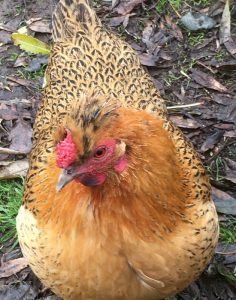 Only one person (Karin Motyer) submitted a photo, and a sad one at that. Titch the chicken had been a long term resident at Montsalvat but died on Friday.
Only one person (Karin Motyer) submitted a photo, and a sad one at that. Titch the chicken had been a long term resident at Montsalvat but died on Friday.
This week’s theme – garden tools
This week’s photo theme will be ‘garden tools’. Send me your interesting photos, together with a title and (if you want) a story, and I will publish them next week.
To get you going, here is a photo of a ‘soil blocker’ that I use, courtesy of KABUU. You press it into a moist mixture of coir and sieved compost and it creates little blocks into which you plant seeds. In comparison with plastic containers, there are no waste materials and the subsequent transplantation shock is arguably less.
Which link was clicked most times in the last newsletter?
Kathy Gardiner’s article about growing peas.
Proverb of the month
In a nutshell. Meaning: concisely stated. This is an extremely old idiom, dating back to AD77 when Pliny The Elder said “Cicero informs us that the Iliad of Homer was written on a piece of parchment so small as to be enclosed in a nutshell“. The odd thing about this is that the Iliad is actually a long book, equating to around 700 pages in modern typeface. In the 17th Century, someone called Pierre Daniel Huet decided to test Pliny/Cicero’s claim and managed to fit the whole of the Iliad onto a piece of parchment sized 27cm x 21cm, using writing so small that no one could read it! So, the original meaning was something like ‘get a lot of information into a small space’ and this only turned into the current meaning of ‘get a lot of information into a few words’ in the mid 19th Century (e.g. in William Makepeace Thackeray’s The Second Funeral of Napoleon).
Read about more food-related proverbs.
Gardening quote of the month
“A society grows great when old men plant trees whose shade they know they shall never sit in.” A Greek proverb.
Joke of the week
Submitted by Sean Flynn: I turned down a job where I would be paid in vegetables … the celery was unacceptable..
Upcoming online events
If you know of any events other than those listed below, email me.
Newly announced events
Fire and fungi: Thursday, 16th July, 6.30-7.30pm; $25 (recommended donation); organised by MYCOmmunity. Read more and book on their website.
Previously announced events
Grow your own fruit trees: Wednesday, 24th June, 7-8.30pm; free; organised by Yarra Ranges Council. Read more and book on EventBrite.
Wonderful world of worms (for kids): Thursday, 25th June, 4-5pm; free; organised by Edendale. Read more and book on WeTeachMe.
Beeswax wraps: Sunday, 28th June, 10am-midday; $50; organised by CERES. Read more and book on Humantix.
Culturing fungi on agar for beginners: Sunday, 5th July, 2-3.30pm; $28; organised by MYCOmmunity. Read more and book on their website.
Backyard beekeeping basics: Tuesday, 28th July, 7-9pm; $50; organised by CERES. Read more and book on Humantix.
Open Table now offer their weekly no waste cook club workshops free and online on Saturdays. As well as cooking (which is actually optional), you will learn about food waste and composting. Register on EventBrite.
Whitehorse Council are publishing on their Youtube channel a video each Monday at 9am on various aspects of sustainability, including beeswax wraps (on 22nd June).
Newsletter reader Chloe Thomson is doing free, weekly podcasts on gardening for Bunnings.
Pip Magazine (some of whose journalists live in North East Melbourne) are producing a series of videos entitled simple skills for self sufficiency.
Good Life Permaculture are producing a series of videos entitled crisis gardening.
All The Dirt is a weekly podcast about gardening.

